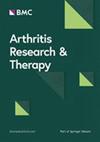Bone marrow lesion coexisted with subchondral bone attrition and/or subchondral bone cyst is associated with knee pain in knee osteoarthritis regardless of cartilage lesion: the Bunkyo health study
IF 4.6
2区 医学
Q1 Medicine
引用次数: 0
Abstract
Subchondral bone changes, which include bone marrow lesion (BML), subchondral bone attrition (SBA) and subchondral bone cyst (SBC) by magnetic resonance imaging (MRI) analysis, are reportedly implicated for knee pain in knee osteoarthritis (OA). However, the relationship between these subchondral bone changes and OA knee pain and the effect of articular cartilage lesion on the pain remain elusive. Elderly subjects (1,145 subjects, 72.9 years old on average) in the Bunkyo Health Study, 71.5% of whom had knee OA with ≥ Kellgren-Lawrence grade 2, were enrolled. Knee pain in daily life over the past few days was measured using Visual Analogue Scale (VAS) in the Japanese Knee Osteoarthritis Measure. The subjects without or with pain were defined if they indicated a pain VAS score of 0 or a pain VAS score of ≥ 1. The association was examined between knee pain and MRI-detected OA structural changes which were determined according to the Whole Organ Magnetic Resonance Imaging Score. While 62.2% of the subjects were free from knee pain, 37.8% of the subjects had knee pain. Knee pain was not related with cartilage lesion without subchondral bone changes (odds ratio [OR]: 1.10 [95% confidence interval [CI]: 0.83–1.46]) or BML alone (OR: 1.32 [95% CI: 0.95–1.83]). However, knee pain was significantly associated with BML coexistent with SBA (OR: 2.22 [95% CI: 1.25–3.97]), SBC (OR: 1.79 [95% CI: 1.28–2.51]), or both SBA and SBC (OR: 2.18 [95% CI: 1.35–3.53]). Similar positive relationships between knee pain and coexisted subchondral bone changes were obtained regardless of the presence or absence of cartilage lesion present above the BML region. When BML was not coexistent with either SBA or SBC regardless of cartilage lesion above the subchondral bone changes, BML was not associated with knee pain (OR: 1.26 [95% CI: 0.90–1.77]) or (OR: 2.16 [95% CI: 0.89–5.23]). BML coexistent with SBA and/or SBC, but not BML without the coexistence, was associated with knee pain in the elderly with knee OA regardless of the presence or absence of cartilage lesion.骨髓病变与软骨下骨磨损和/或软骨下骨囊肿共存与膝关节骨性关节炎的膝关节疼痛有关,无论软骨病变如何:文京健康研究
据报道,通过磁共振成像(MRI)分析,包括骨髓病变(BML)、软骨下骨磨损(SBA)和软骨下骨囊肿(SBC)在内的软骨下骨改变与膝骨关节炎(OA)的膝关节疼痛有关。然而,这些软骨下骨变化与OA膝关节疼痛的关系以及关节软骨病变对疼痛的影响尚不清楚。Bunkyo健康研究的老年受试者(1145名,平均年龄72.9岁),其中71.5%患有≥kellgreen - lawrence等级2的膝关节OA。使用日本膝骨关节炎量表中的视觉模拟量表(VAS)测量过去几天日常生活中的膝关节疼痛。如果受试者的疼痛VAS评分为0或疼痛VAS评分≥1,则定义为无疼痛或有疼痛。研究了膝关节疼痛与mri检测到的OA结构变化之间的关系,这些变化是根据全器官磁共振成像评分确定的。62.2%的受试者无膝关节疼痛,37.8%的受试者有膝关节疼痛。膝关节疼痛与软骨病变无软骨下骨改变无关(优势比[OR]: 1.10[95%可信区间[CI]: 0.83-1.46])或单纯BML (OR: 1.32 [95% CI: 0.95-1.83])。然而,膝关节疼痛与BML合并SBA (OR: 2.22 [95% CI: 1.25-3.97])、SBC (OR: 1.79 [95% CI: 1.28-2.51])或SBA和SBC (OR: 2.18 [95% CI: 1.35-3.53])显著相关。无论BML区域上方是否存在软骨病变,膝关节疼痛与共存的软骨下骨变化之间都存在类似的正相关关系。当BML不与SBA或SBC共存时,无论软骨下骨改变是否有软骨病变,BML与膝关节疼痛无关(or: 1.26 [95% CI: 0.90-1.77])或(or: 2.16 [95% CI: 0.89-5.23])。BML与SBA和/或SBC共存,而不共存的BML与老年膝关节OA患者的膝关节疼痛相关,无论是否存在软骨病变。
本文章由计算机程序翻译,如有差异,请以英文原文为准。
求助全文
约1分钟内获得全文
求助全文
来源期刊

Arthritis Research & Therapy
RHEUMATOLOGY-
CiteScore
8.60
自引率
2.00%
发文量
261
审稿时长
14 weeks
期刊介绍:
Established in 1999, Arthritis Research and Therapy is an international, open access, peer-reviewed journal, publishing original articles in the area of musculoskeletal research and therapy as well as, reviews, commentaries and reports. A major focus of the journal is on the immunologic processes leading to inflammation, damage and repair as they relate to autoimmune rheumatic and musculoskeletal conditions, and which inform the translation of this knowledge into advances in clinical care. Original basic, translational and clinical research is considered for publication along with results of early and late phase therapeutic trials, especially as they pertain to the underpinning science that informs clinical observations in interventional studies.
 求助内容:
求助内容: 应助结果提醒方式:
应助结果提醒方式:


